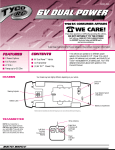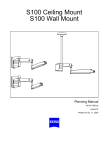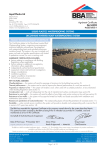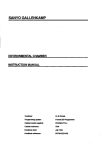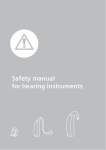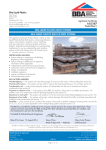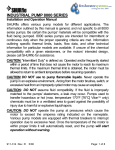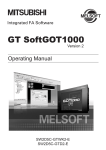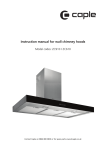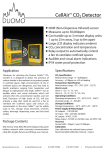Download AUTOFLASH AF3 GETTING STARTED
Transcript
GALLENKAMP AUTOFLASH AF3 GETTING STARTED SANYO GALLENKAMP PLC Health and Safety at Work Sanyo Gallenkamp is required under the Health and Safety at work, etc. Act, 1974 and other UK legislation as designers, manufacturers, suppliers and importers of articles for use at work to ensure that, as far as is reasonably practicable, articles which we design, produce, supply or import are safe and without risk to health. We are required to provide information on the safety and handling precautions to be observed when installing, operating, maintaining and servicing our products. Such advice is contained in this manual. We are also obliged to update this information should circumstances change and to operate a system to this end. We should also like to point out, however that you as users have an important responsibility in the provision and maintenance of safe working practices and conditions. Accordingly, we draw the following matters to your attention: 1. This apparatus should only be used as intended and within its design parameters by suitably qualified and trained personnel who have read and understood the relevant sections of this manual. 2. This manual should be readily available to such personnel at all times. 3. In addition to that which is written in the manual, normal common-sense safety precautions must be taken at all times to avoid the possibility of accidents. Particular care is required when working with apparatus at high temperature or pressure. 4. Installation, maintenance, servicing and connection to electrical supplies should only be carried out by suitably trained personnel. TECHNICAL SUPPORT If you are in any doubt whatsoever regarding the correct use of this apparatus, or if you require any technical data or assistance, please contact the Sanyo Gallenkamp Customer Technical Support Department at; Park House Telephone : (0116)2630530 Meridian East Fax: (0116)2630353 Telex: 347269 MSE G Meridian Business Park Leicester LE3 2UZ WARRANTY SERVICE AND MAINTENANCE Telephone : (01293) 561222 Fisons Instruments Sussex Manor Park Fax: (01293) 561980 Gatwick Road Crawley West Sussex RH10 2QQ OVERSEAS CUSTOMERS: Should contact their local Sanyo Gallenkamp Distributor ELECTRICITY SUPPLIES: Voltage and frequency Sanyo Gallenkamp electrical apparatus is offered and labelled for one, or for a choice of two or more voltage ranges ind, where necessary, different frequencies of mains supply. Sanyo Gallenkamp does not accept any responsibility for he operation of any such apparatus should it be connected to electricity supplies which are normally outside, or vary outside, the stated voltage and frequency values for which it is designed, nor for any consequential loss, damage or njury, howsoever caused. Read This Before Use! Operating Guide to The Gallenkamp Autoflash AF3. This Operating Guide should be used in conjunction with the Operating Manual supplied with the unit. Fig 1 Fig 2 Getting Started 1. Turn on Gas, Water and Electricity Supplies to the unit. 2. Switch ON Main Switch (rear of unit adjacent to power cord). The unit will perform a self check routine. 3. Light the pilot flame (Fig 2, Item B). Check that the flame extends to the reference bead (Fig 2, Item C). If necessary adjust, using the gas valve on the rear of the unit (Fig 1, Item A). 4. If necessary adjust the dip mechanism valve (Fig 2, Item D) such that the test flame is the same size as the reference bead. 5. Clean and dry the test cup. Being careful not to wet the cup above the mark, fill with the test sample as far as the scribed line. Alternatively measure out 70 ml of sample into the test cup from a cylinder or a syringe. 6. Assemble the lid to the cup. Place into the heating block. Swing the test mechanism (Fig 2) into place and engage the stirrer drive (Fig 2, Item E). Connect the thermometer probe (Fig 2, Item F). You are now ready to begin testing. All tests can be aborted at any time by pressing the reset button. Test A. - For Samples of Known Flashpoint. 1. Set the expected Flashpoint on the Set panel. 2. Press the Start button. The test cycle will now begin. Dipping will commence about 20°C below the expected flashpoint temperature. CONTENTS CHECK LIST Please ensure that the following items have been delivered:One Gallenkamp Autoflash Apparatus (240V, 220V, 110V or 120V) consisting of:One Test Unit complete with Test Cup and Probe One Control Unit One Moulded Mains Lead One Thermometer Test Lead Set of 3 calibration resistors (100 ohms, 212.02 ohms, 138.5 ohms) One User Manual If any of the items are missing please contact your Gallenkamp Sales Coordinator immediately (distributor for overseas customers) quoting your order number. NB Ensure that the correct voltage has been ordered before connecting power to the unit. The voltage can be found on the ratings plates at the rear of the Autoflash. Test B. - For Samples of Known Flashpoints Above 100°C. To reduce the time taken to perform the test a rapid heat function is available. NOTE - This feature cannot be operated in conjunction with the Search Function. 1. Set the Expected flashpoint on the Set panel. 2. Press the Rapid Heat button, the light will illuminate. 3. Press Start. The temperature will rise rapidly to 60°C below the set Flashpoint. The rapid heat light will then go out and the heating rate will slow. At about 20°C below the set flashpoint dipping will commence. Test C. - For Samples of Unknown Flashpoint. This function cannot be used in conjunction with the rapid heat facility. 1. The expected flashpoint should be set to a high guess on the Set panel. 2. Press the Search Button, the light will illuminate. 3. Press Start Button. The light will illuminate and the test commence. Flashpoint dipping will commence. 4. When a flash is detected the Flash Light will illuminate and the alarm will sound. Press the alarm button to silence the alarm. Record the Flashpoint temperature. Press the reset button. Allow the sample to cool. Check that the pilot light is still alight. Relight and reset the flame if necessary. 5. Clean, dry and refill the cup with a fresh sample. 6. Use the recorded flashpoint as the Known flashpoint and continue as in Test A. When The Test is Finished . . . The test will finish when either a Flashpoint is detected, or no Flash has occurred up to about 20°C above the expected flashpoint. If a Flashpoint is detected then the Flash light will illuminate, the alarm will sound and the Flash temperature will be displayed. The unit will automatically cool the sample. Silence the alarm by pressing the alarm button (alarm light will go out). Record the Flashpoint. Press the reset button. Check that the pilot light is still alight. If necessary, relight and reset the pilot and test flames. The unit is now ready for the next test. If no flash is detected the No Flash light will illuminate and the alarm will sound. Silence the alarm by pressing the alarm button (alarm light will go out). Determine why no flash occurred, e.g. Test flame out, Expected flashpoint set too low, etc. Repeat test with a fresh sample. When You Have Finished. When all tests are complete turn off the Main Power switch. Turn off the Water, Gas and Electricity at the supplies. Clean and dry cup. Check that the sliding mechanism on the lid is clean and dry. SANYO Gallenkamp PLC GETTING STARTED 1. Install the Autoflash - AF3 Refer to Chapter 2 in the User Manual and install the unit. 2. Test Cup, Probe and Test Flame Refer to Chapter 3 in the User Manual and familiarise yourself with the test cup, probe and test flame assembly. Ensure at all times that the sliding faces on the shutter mechanism are kept clean. 3. Power up the AF3 Switch on at the mains switch. This is situated at the right hand rear of the control unit when viewed from the front. The unit will run through a quick self test. 4. Light the Test Flame Turn on the gas using the valve situated to the lower left hand rear of the test unit. Light the gas and adjust the pilot flame until it just extends to the reference bead. Adjust the valve on the test flame block itself until the flame is the same size (4mm dia) as the reference bead. 5. Fill the Test Cup Ensure that the test cup is clean and dry. Fill the cup with sample to the scribed mark. Alternatively use a measuring cylinder to transfer 70ml of sample. Take care neither to overfill nor wet the cup above the mark. 6. Fit the Cup into place Assemble the Cup and lid and place the assembly into the heating block. Ensure that it is seated correctly. Swing the Test Flame dipping mechanism into place. Ensure that the stirrer drive is engaged. Insert the connecting plug into the resistance thermometer probe. Check that the plug is fully engaged. Always disconnect by pulling the plug not the lead. 7. Set the Expected Flashpoint Use the Temp Set button to set the expected flashpoint temperature. Press each button repeatedly, or hold each button down, until the desired setting is displayed. Care must be taken not to set the expected flashpoint at too high a temperature because of the danger of combustion/boil over of highly flammable substances. Note that the maximum permissible temperature setting is 399°C (750°F). Any illegal flashpoint settings will be detected and registered as an error. For a list of error codes see the appendix in the User Manual. To recover from an error condition press Reset. ii) The No Flash LED is Illuminated No Flash has occurred. If a flash is not detected within +_ 20°C of the set Expected Flashpoint the Autoflash will stop the test. Determine the reason for a No Flash situation, e.g. Test Flame out, Expected Flashpoint set too low etc. (See section 6.6.4 in the User Manual). Repeat the test with a fresh sample. For more detailed information on the operation of the Autoflash-AF3 and the method of test refer to Chapters 5 and 6 in the User Manual.








